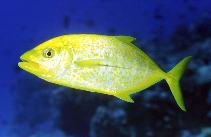Flavocaranx bajad (Fabricius, 1775)
Orangespotted trevally
United Arab Emirates country information
Common names:
[No common name]
Occurrence: native
Salinity: marine
Abundance: | Ref:
Importance: | Ref:
Aquaculture: | Ref:
Regulations: | Ref:
Uses: no uses
Comments:
National Checklist:
Country Information: https://www.cia.gov/library/publications/resources/the-world-factbook/geos/tc.html
National Fisheries Authority:
Occurrences: Occurrences Point map
Main Ref: Smith-Vaniz, W.F., 1984
National Database:
Occurrence: native
Salinity: marine
Abundance: | Ref:
Importance: | Ref:
Aquaculture: | Ref:
Regulations: | Ref:
Uses: no uses
Comments:
National Checklist:
Country Information: https://www.cia.gov/library/publications/resources/the-world-factbook/geos/tc.html
National Fisheries Authority:
Occurrences: Occurrences Point map
Main Ref: Smith-Vaniz, W.F., 1984
National Database:
Common names from other countries
分類 / Names 共通名の | 類義語 | Catalog of Fishes(部類, 種) | ITIS | CoL | WoRMS | Cloffa
> Carangiformes (Jacks) > Carangidae (Jacks and pompanos) > Caranginae
Etymology: Flavocaranx: Name from Latin 'favo' meaning 'yellow' and Caranx, which is the type genus of Carangidae; referring to yellowish body color.
Etymology: Flavocaranx: Name from Latin 'favo' meaning 'yellow' and Caranx, which is the type genus of Carangidae; referring to yellowish body color.
Environment: milieu / climate zone / depth range / distribution range 生態学
海 関連する礁; 深さの範囲 2 - 70 m (Ref. 90102). Tropical; 35°N - 8°S, 33°E - 150°E
分布 国々 | 国連食糧農業機関の区域 | エコシステム | 事件 | Point map | 導入 | Faunafri
Indo-West Pacific: Red Sea, Gulf of Aden, Persian Gulf, and the Gulf of Oman to Indonesia, the Gulf of Thailand, the Philippines, and Okinawa, Japan.
Length at first maturity / サイズ / 重さ / 年齢
Maturity: Lm 24.7 range ? - ? cm
Max length : 55.0 cm TL オス/雌雄の選別がない; (Ref. 3287); common length : 42.0 cm TL オス/雌雄の選別がない; (Ref. 5450)
Max length : 55.0 cm TL オス/雌雄の選別がない; (Ref. 3287); common length : 42.0 cm TL オス/雌雄の選別がない; (Ref. 5450)
簡単な記述 検索表 | 形態学 | 形態計測学
背面の脊椎 (合計) : 9; 背鰭 (合計) : 24 - 26; 肛門の骨: 3; 臀鰭: 22 - 24.
Adults are common along coastal reef slopes or around large coral heads in lagoons (Ref. 48635). A xanthic form often seen in muddy bays mixes in schools (Ref. 48635). Juveniles solitary in sheltered coastal basys (Ref. 48635).
Life cycle and mating behavior 成熟 | 繁殖 | 放精 | 卵 | 生産力 | 幼生
主な参考文献
Upload your references | 参考文献 | コーディネーター : Smith-Vaniz, William F. | 協力者
Smith-Vaniz, W.F., 1984. Carangidae. In W. Fischer and G. Bianchi (eds.) FAO species identification sheets for fishery purposes. Western Indian Ocean fishing area 51. Vol. 1. [pag. var.]. FAO, Rome. (Ref. 3287)
人間に対する脅威
Harmless
Human uses
水産業: 商業; ゲームフィッシュ: はい
FAO(水産業: 代謝; publication : search) | FishSource | 私達の周りの海
より多くの情報
Population dynamics
成長のパラメーター
Max. ages / sizes
Length-weight rel.
Length-length rel.
体長組成
Mass conversion
補充
豊度
成長のパラメーター
Max. ages / sizes
Length-weight rel.
Length-length rel.
体長組成
Mass conversion
補充
豊度
Anatomy
カマ
Brain
Otolith
カマ
Brain
Otolith
Physiology
Body composition
Nutrients
酸素消費
水泳形態
泳ぐ速さ
Visual pigments
Fish sound
Diseases & Parasites
Toxicity (LC50s)
Body composition
Nutrients
酸素消費
水泳形態
泳ぐ速さ
Visual pigments
Fish sound
Diseases & Parasites
Toxicity (LC50s)
Genetics
遺伝子の
Heterozygosity
遺伝
遺伝子の
Heterozygosity
遺伝
用具
Bio-Quiz | E-book | 野外観察図鑑 | 検索表 | Length-frequency wizard | 生活史の基盤ツール | 目的のマップ | Classification Tree
| Catch-MSY |
特記事項
XMLをダウンロードして下さい
インターネットの情報源
Aquatic Commons | BHL | Cloffa | Websites from users | Check FishWatcher | CISTI | Catalog of Fishes(部類, 種) | DiscoverLife | ECOTOX | Faunafri | Fishtrace | GenBank(ゲノム, ヌクレオチド) | GloBI | GOBASE | | Google Books | Google Scholar | Google | IGFA World Record | MitoFish | 国のデーターベース | Otolith Atlas of Taiwan Fishes | PubMed | Reef Life Survey | Scirus | SeaLifeBase | 生命の木 | Wikipedia(行く, 検索する) | World Records Freshwater Fishing | 動物に関する記録
Estimates based on models
Preferred temperature (Ref. 115969): 25.5 - 29.2, mean 28.5 (based on 944 cells).
Phylogenetic diversity index (Ref. 82804): PD50 = 0.5000 [Uniqueness, from 0.5 = low to 2.0 = high].
Bayesian length-weight: a=0.01175 (0.00778 - 0.01775), b=2.92 (2.80 - 3.04), in cm Total Length, based on LWR estimates for this species & (Sub)family-body (Ref. 93245).
栄養段階 (Ref. 69278): 4.3 ±0.59 se; based on food items.
回復力 (Ref. 120179): 手段, 1.4年~4.4年の倍増期間の最小個体群 (Tmax=8; K = 0.24-0.59).
Fishing Vulnerability (Ref. 59153): Moderate vulnerability (39 of 100).
Climate Vulnerability (Ref. 125649): Very high vulnerability (90 of 100).




